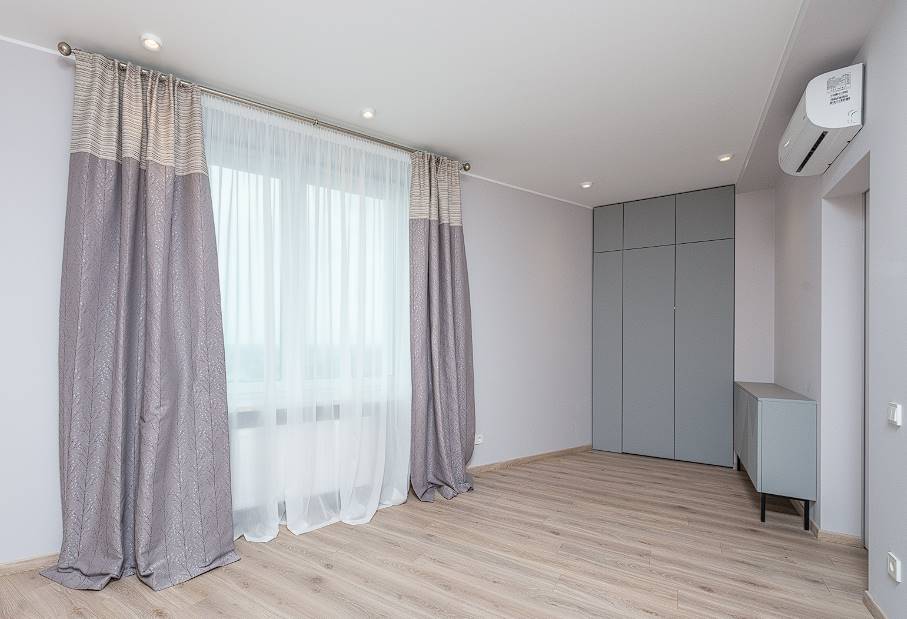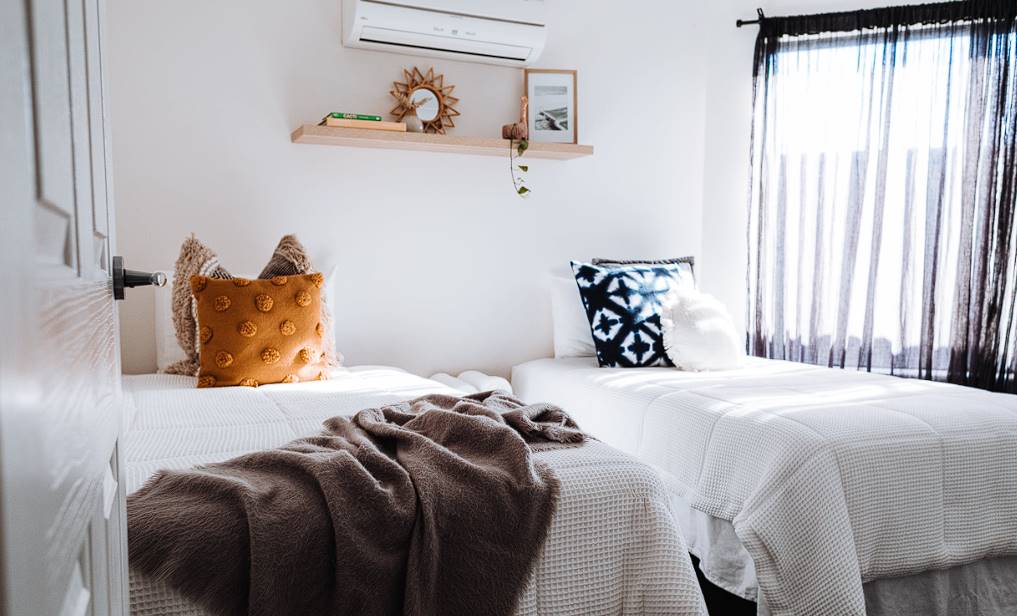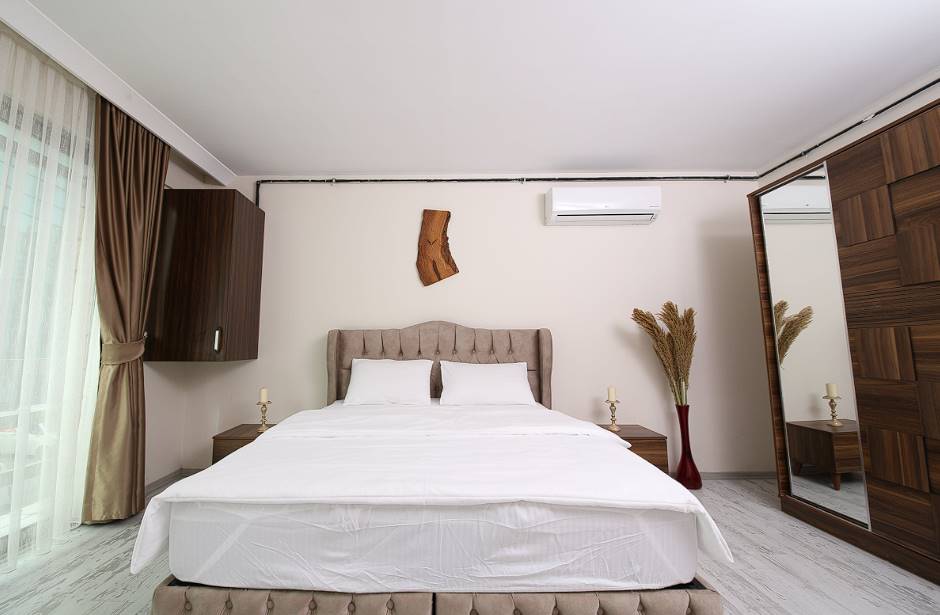If you are considering purchasing a new air conditioner with a split system, you may have observed that many different types of systems are meant to perform functionally equivalent functions. How can you determine which central air conditioning system is ideal for your house?
We explain what a due to multiple air conditioner is, the benefits and drawbacks of using one, how a split system works, the size of the unit you'll need, the cost of installation, and how to clean your air conditioning unit.
What Is A Split Air Conditioning System?
A split system air conditioner is a type of space heating and cooling that regulates the temperature in a specific room. These systems separate the air conditioner into an indoor and outside component, as opposed to a single component like older window units.
The indoor unit should be mounted high on an interior wall, and the outdoor unit should be mounted high on an exterior wall. The living room, the study, the home office, and the bedrooms are ideal locations for installing split systems.
How Does A Split System Air Conditioner Work?
The magic ingredient in air conditioning is a chemical called refrigerant. Its rapid phase transition from gas to liquid results in a temperature shift. The HVAC system employs this temperature variation to heat or cool incoming air.
The compressor of a split system air conditioner pressurises and warms the refrigerant gas before it is released into the indoor unit. The hot, pressured gas is routed through a series of condenser tubes, cooled and condenses back into a gas at atmospheric pressure.
The air conditioner draws in warm air from the room and uses the temperature difference between the refrigerant and the air to chill the air. Air sucked into the interior unit is cooled as it travels through an evaporator coil chilled by the refrigerant gas. The cooled air is recycled and recirculated.
The indoor and outdoor components of the refrigeration system are linked together by high-pressure gas pipes and electrical wires, respectively, so that the refrigerant can move freely throughout the system.
What Are The Benefits Of Using A Split System Air Conditioner?
A split system air conditioner is a practical solution if you only need to chill some rooms in your house while it's hot outside. Compared to traditional ducted air conditioning systems and window AC units, these systems provide a number of advantages. The following are examples of advantages split-system air conditioners have over conventional ones.
Energy-Efficient
When compared to ducted air conditioning systems, split systems save electricity. Ducted air causes energy loss because of the ductwork that must be used. If you want to keep your house cool, this could cause your air conditioner to run more frequently. One way in which split-system air conditioners save power is by not requiring the installation of ductwork.
These systems can also be configured to cool specific portions of your home rather than the entire property, resulting in an even greater reduction in energy use. Your monthly energy costs should be cheaper if you have a more energy-efficient system.
A large portion of the energy is lost by centres is due to ductwork; for example, leaking ductwork can waste as much as 30 percent of the energy used to cool an area.
If the ductwork is not insulated or is located in an uncontrolled environment, it becomes difficult to keep up a high standard of energy efficiency. The ductless design offered by split systems increases the likelihood of cost and energy savings, as well as the manageability of future utility bills.
Zoning
By dividing the house into individual "zones," split-system air conditioners can independently chill each of your home's rooms. Instead of a single thermostat controlling the entire air conditioning system, you will have individual controls for each zone.
Multiple thermostats installed throughout the home allow you to control the temperature in different areas separately. As a result, you'll spend less money on energy over time.
Air conditioners without ducts are a great option for homes that are heated electrically, those with hydronic heating systems, and older homes with insufficient distribution.
Increased Security
Anybody who wants to break in can easily open a window's air conditioner and enter the building. A split system air conditioner, on the other hand, does not have any operable windows. In contrast to an open section in your wall or window, the tiny one you need for your conduit won't make it any easier for a burglar to break in.
Cost-Efficient
Installing a split-system air conditioner in your house is an easier and more cost-effective approach to keep the temperature inside your home at a more comfortable level. These systems often have a lower purchase price and labour to set them up. They save money because they have a lower energy footprint and need less upkeep. By making this investment, you will be able to regularly and inexpensively chill your home.
Easier Installation
Installing a split system is easier than installing a traditional system. In addition to not needing ducting, the link between your interior and outdoor units needs only a 3-inch-wide hole. After it is complete, you'll need power and a place to mount your devices. Your interior and outdoor units can be placed up to 100 feet apart thanks to the various refrigerant tube lengths from different manufacturers.
Unlike ducted air conditioning systems, split system air conditioners do not necessitate ducting to chill the air in your home effectively. On the other hand, these systems feature an indoor and an outdoor unit connected by copper tubing and cables for easy installation. Unlike window units, split-system air conditioners can be installed in rooms without windows.
Easy Maintenance
A technician should often be called out on a regular basis to inspect and maintain a ducted air conditioner to keep it in good working order. Minimal care is required for a split system air conditioner and may usually be done by the owner.
A new filter may need to be installed. Sometimes, this can be as simple as reusing the present filter after a thorough cleaning. Your split system air conditioner will continue to perform well for many years with no upkeep.
They Complement Your Décor.
A split-system air conditioner gives you a lot of options for indoor placement. You can mount them to the ceiling or the walls of your room. Moreover, a few of them sell jackets that are fashionable, stylish, and sophisticated.
In addition, a hole doesn't need to be drilled in the wall or the window to install a split system, which is something that can't be said of window units. Split systems are flexible in terms of placement.
A Split System Air Conditioner Is Quiet To Operate.
When they are operating, window units can make a lot of noise, which can be very distracting. These systems have a fan and condenser inside your home, generating a large amount of noise while functioning. Ducted systems are more disruptive to the surrounding community because they are larger and generate all their noise from a single location.
Air conditioners with split systems operate in a manner that is significantly more unobtrusive than other kinds of air conditioning systems. The components that produce the most noise are housed in the smaller exterior unit, where you won't be able to hear them as clearly. This not only helps to keep your home cool and pleasant, but it also reduces the amount of noise that can be heard within.
What Split System Size Do I Need?
The efficiency and cost-effectiveness of your air conditioner will greatly depend on your ability to determine its size correctly. Too large of an air conditioner will waste electricity, while too little will not cool the space adequately.
To help you decide what size split system you need, consider these four variables:
Room Size
The size of the room, including its square footage and total volume, is a major consideration when choosing an air conditioner. It takes more effort to cool a room with higher ceilings.
In general, the following applies:
- A 45m2 to 65m2 room will need a 7-8kW unit
- A 10m2 to 20m2 room will need a 2.6kW unit
- A 30m2 to 45m2 room will need a 5-6kW unit
- A 20m2 to 30m2 room will need a 3.5kW unit
Location
Australia's climate is incredibly diverse. Air conditioners in Darwin need to be able to dissipate heat at a much higher rate than those in Hobart. We still advise reverse cycle split system air conditioning units to ensure your year-round comfort, despite the fact that snow and boiling temperatures are both relatively rare in Newcastle.
Insulation
Insulating your ceilings is one of the most important things you can do to improve your home's energy efficiency. If you have good insulation, you'll be able to keep the cool air inside for longer, which will help your air conditioner work more effectively and save you money.
Orientation
Which direction does the room face when you enter? In the summer, a large window facing either the north or the west will let in a lot of heat, whereas a south and sheltered window will be much cooler.
How To Properly Maintain A Split-System Air Conditioner?
You should maintain and clean your air conditioner twice every year. Keeping up with the unit's cleaning and maintenance schedule will help it work more smoothly and reduce the need for expensive repairs.
Before you begin cleaning any air conditioner component with a split system, you must ensure that the system is completely turned off.
The Indoor Unit
There are dust filters in the interior unit that must be maintained. The filters in your air conditioner will need to be cleaned more frequently the more you use them. It takes more energy for the air conditioner to blow cool air through blocked dust filters, which raises energy bills.
The plastic cover protecting the dust filtration can be quickly and easily removed for cleaning. Outside, give it a good brushing, shake, or vacuum with the cleaning brush attachment. Whenever they become too dirty, the dust filtration can be washed in warm, soapy water. You should let them dry in the air before putting them back into the air conditioner.
Also, take out the louvres (blades) from the inside of the AC unit. If that's the case, use a vacuum cleaner or a cloth to clean the area behind them within the unit thoroughly.
The Outdoor Unit
Maintaining the outside unit requires keeping it free of grass and plants and regular brushing to remove leaves, dust, and cobwebs. To assist in the removal of dust brought in from the environment, you can use a vacuum cleaner to go over the air intake. However, it would be best if you let the experts handle cleaning the interior parts of the device.
What Is A Split Inverter System?
The compressor in an air conditioner is responsible for pressurising and depressurising the refrigerant as it moves through the system. A typical split system compressor can run at full speed or be turned off entirely. When the set point temperature is reached while the compressor is running at full capacity, it automatically shuts off.
Instead of running at full blast until the desired temperature is reached, an inverter split system's compressor may vary its speed to circulate the precise amount of refrigerant. Since conventional split systems lose efficiency at the switch, an inverter split system is roughly 30% more effective. Inverter technology is widely used in today's air conditioning systems.
The inverter split system is typically quieter than a conventional split system because the compressor can run at a constant, efficient speed rather than alternating between idle and full speed. This excessive mode of operation also shortens the compressor's life, increasing maintenance expenses.
What Is The Distinction Between Split System And Ducted Air Conditioning?
The indoor unit of a split system is fixed on the wall and distributes the conditioned air, while the outdoor unit is responsible for refrigerant compression. High-pressure gas lines and electrical wires link these two modules together.
The air from ducted air conditioning is distributed throughout a building by ducts, similar to conventional split-system air conditioning. The indoor unit in a ducted system is concealed in the ceiling or floor. Instead of delivering conditioned air directly into the room, vents distribute it throughout the building.
Ducted air conditioning allows for the separation of the building into customisable "zones" where the temperature and humidity may be adjusted independently by regulating airflow within the ductwork. By turning off the air conditioning in unoccupied spaces, you can save money on your monthly utility bills and help the environment simultaneously. Ducted air conditioning is ideal for homes that need to cool or heat a wide area that spans more than one room.
A remote operates a split system, whereas a panel mounted to the wall is used for a ducted system. Both can have smart technology added to them, allowing them to be managed remotely through electronic devices like smartphones and laptops.
Conclusion
A split system air conditioner is a type of space heating and cooling that regulates the temperature in a specific room. These systems separate the air conditioner into an indoor and outdoor component, as opposed to a single component like older window units. The indoor unit should be mounted high on an interior wall, and the outdoor unit should be mounted high on an exterior wall.
The compressor of a split system air conditioner pressurizes and warms the refrigerant gas before it is released into the indoor unit. The hot, pressured gas is routed through a series of condenser tubes, cooled, and condensed back into a gas at atmospheric pressure. The air conditioner draws in warm air from the room and uses the temperature difference between the refrigerant and the air to chill the air. The indoor and outdoor components of the refrigeration system are linked together by high-pressure gas pipes and electrical wires, respectively, so that the refrigerant can move freely throughout the system.
Split systems offer several advantages over traditional ducted air conditioning systems and window AC units. They are energy-efficient, as they do not require the installation of ductwork and can be configured to cool specific portions of your home rather than the entire property. Split systems can also be configured to cool specific portions of your home rather than the entire property, resulting in even greater reduction in energy use.
Zoning allows split-system air conditioners to independently chill each of your home's rooms, with multiple thermostats installed throughout the home. This increases the likelihood of cost and energy savings, as well as the manageability of future utility bills.
In addition to these benefits, split systems are also more cost-effective. They often have a lower purchase price and labor to set up, and they require less upkeep. Installation is easier than installing a traditional system, as the link between the interior and outdoor units needs only a 3-inch-wide hole.
Maintenance is easier for split systems, as they do not require ducting to chill the air effectively. A technician should be called out on a regular basis to inspect and maintain a ducted air conditioner, while a split system air conditioner can continue to perform well without upkeep.
In conclusion, split systems offer numerous benefits, including energy efficiency, convenience, ease of installation, and compatibility with various decor options.
A split system air conditioner is a quiet and efficient option for cooling homes. It operates in a more unobtrusive manner, with components that produce the most noise housed in the smaller exterior unit. The size of the split system depends on factors such as room size, location, insulation, and orientation. For example, a 45m2 to 65m2 room will need a 7-8kW unit, while a 10m2 to 20m2 room will need a 2.6kW unit, a 30m2 to 45m2 room will need a 5-6kW unit, and a 20m2 to 30m2 room will need a 3.5kW unit.
Maintaining a split system air conditioner involves cleaning twice a year, ensuring the system is completely turned off before starting. Dust filters in the interior unit must be maintained, as they require more energy to blow cool air through blocked filters, increasing energy bills. The plastic cover protecting the dust filtration can be easily removed for cleaning, and the area behind them should be cleaned thoroughly.
A split inverter system is a type of air conditioner that uses an inverter compressor to pressurize and depressurize the refrigerant as it moves through the system. This is 30% more effective than conventional split systems, as the compressor can run at a constant, efficient speed rather than alternating between idle and full speed. This efficiency also shortens the compressor's life, increasing maintenance expenses.
The difference between split systems and ducted systems is that the indoor unit is fixed on the wall and distributes the conditioned air, while the outdoor unit is responsible for refrigerant compression. Ducted air conditioning allows for the separation of the building into customisable "zones" where temperature and humidity can be adjusted independently by regulating airflow within the ductwork. By turning off the air conditioning in unoccupied spaces, you can save money on utility bills and help the environment simultaneously.
Both split and ducted systems can be operated remotely through electronic devices like smartphones and laptops. Both types of air conditioners have their advantages and disadvantages, but the choice depends on your specific needs and budget.
Content Summary:
- If you are considering purchasing a new air conditioner with a split system, you may have observed that many different types of systems are meant to perform functionally equivalent functions.
- How can you determine which central air conditioning system is ideal for your house?
- We explain what a due to multiple air conditioner is, the benefits and drawbacks of using one, how a split system works, the size of the unit you'll need, the cost of installation, and how to clean your air conditioning unit.
- A split system air conditioner is a type of space heating and cooling that regulates the temperature in a specific room.
- These systems separate the air conditioner into an indoor and outside component, as opposed to a single component like older window units.
- The compressor of a split system air conditioner pressurises and warms the refrigerant gas before it is released into the indoor unit.
- A split system air conditioner is a practical solution if you only need to chill some rooms in your house while it's hot outside.
- Compared to traditional ducted air conditioning systems and window AC units, these systems provide a number of advantages.
- The following are examples of advantages split-system air conditioners have over conventional ones.
- When compared to ducted air conditioning systems, split systems save electricity.
- One way in which split-system air conditioners save power is by not requiring the installation of ductwork.
- Your monthly energy costs should be cheaper if you have a more energy-efficient system.
- By dividing the house into individual "zones," split-system air conditioners can independently chill each of your home's rooms.
- Instead of a single thermostat controlling the entire air conditioning system, you will have individual controls for each zone.
- A split system air conditioner, on the other hand, does not have any operable windows.
- Installing a split-system air conditioner in your house is an easier and more cost-effective approach to keep the temperature inside your home at a more comfortable level.
- Easier Installation Installing a split system is easier than installing a traditional system.
- In addition to not needing ducting, the link between your interior and outdoor units needs only a 3-inch-wide hole.
- After it is complete, you'll need power and a place to mount your devices.
- Unlike ducted air conditioning systems, split system air conditioners do not necessitate ducting to chill the air in your home effectively.
- Unlike window units, split-system air conditioners can be installed in rooms without windows.
- Minimal care is required for a split system air conditioner and may usually be done by the owner.
- A split-system air conditioner gives you a lot of options for indoor placement.
- Split systems are flexible in terms of placement.
- The size of the room, including its square footage and total volume, is a major consideration when choosing an air conditioner.
- It takes more effort to cool a room with higher ceilings.
- You should maintain and clean your air conditioner twice every year.
- The plastic cover protecting the dust filtration can be quickly and easily removed for cleaning.
- You should let them dry in the air before putting them back into the air conditioner.
- Also, take out the louvres (blades) from the inside of the AC unit.
- If that's the case, use a vacuum cleaner or a cloth to clean the area behind them within the unit thoroughly.
- Maintaining the outside unit requires keeping it free of grass and plants and regular brushing to remove leaves, dust, and cobwebs.
- To assist in the removal of dust brought in from the environment, you can use a vacuum cleaner to go over the air intake.
- The compressor in an air conditioner is responsible for pressurising and depressurising the refrigerant as it moves through the system.
- A typical split system compressor can run at full speed or be turned off entirely.
- Since conventional split systems lose efficiency at the switch, an inverter split system is roughly 30% more effective.
- The inverter split system is typically quieter than a conventional split system because the compressor can run at a constant, efficient speed rather than alternating between idle and full speed.
- The indoor unit of a split system is fixed on the wall and distributes the conditioned air, while the outdoor unit is responsible for refrigerant compression.
- The air from ducted air conditioning is distributed throughout a building by ducts, similar to conventional split-system air conditioning.
- By turning off the air conditioning in unoccupied spaces, you can save money on your monthly utility bills and help the environment simultaneously.
- A remote operates a split system, whereas a panel mounted to the wall is used for a ducted system.
Frequently Asked Questions
Yes, split-system air conditioners are versatile and can be effectively used in residential and commercial settings. They offer customisable cooling solutions for various environments.
Yes, professional installation is crucial to ensure optimal performance and efficiency. Only qualified technicians have the expertise to install the unit correctly.
While it may be tempting, hiring a professional for installation is highly recommended. Improper installation can lead to inefficiency, reduced lifespan, and potential safety hazards.
With proper maintenance and care, a well-installed split system air conditioner can last up to 15-20 years. Regular servicing and timely repairs can significantly extend its lifespan.
Many split system units come with a reverse cycle function, allowing them to operate as heaters in colder months. This dual functionality makes them a versatile year-round solution for climate control.



